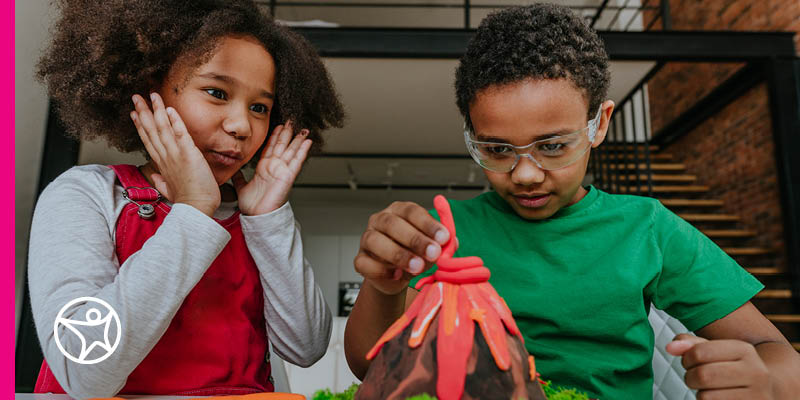The Benefits of Music Education for Children
by Phoebe Brown
byAlyssa Austin
10 min to readFor many parents, there’s nothing more challenging than helping their kids with a school science fair project. Knowing that the project will make a big impact on your child’s grade—and that the deadline is fast approaching—can lead to a stressful situation. But with careful planning, good resources, and some science project help from the experts, you and your student can have fun while learning more about the scientific method.
In general, science fair projects fall into one of three main categories: research, experimental, or a demonstration of how nature works.
In a research project, students compare and contrast data from studies already conducted in order to answer a question they have developed. For example, if a student is interested in what species can survive in outer space, they could collect several studies on this topic and use the evidence presented in them to develop an answer to the question.
An experiment is what most people think of when they think of science fair projects. In this approach, students follow the steps of the scientific method in order to design an experiment that provides answers to a question that interests them.
Students can demonstrate how nature works by building models. Models can be built by hand or on a computer. When visitors (or judges) visit a science fair project, concepts are instantly more relatable if they can push a button or move some part of the model and observe the results.
When it comes to science fair projects, a compelling idea can make all the difference. Finding an experiment idea that your student is excited about can help them get more out of the process of doing a science fair project. Read on for some helpful tips in finding and vetting ideas for science fair projects.
We all know that the internet is a wonderful resource, but not all sites are appropriate for children, so be prepared to provide supervision appropriate to your child’s age. It also can be challenging to narrow down your options. To get you started, here are some reliable recommended online resources that offer project suggestions, advice for parents, and sources of publicly available data.
| Description | Site | Audience | Type |
|---|---|---|---|
| Steve Spangler Science Fair Experiments | www.stevespanglerscience.com | K–12 |
|
| Jet Propulsion Laboratory: How to Do a Science Fair Project? | www.jpl.nasa.gov | K–12, parents |
|
| Science Buddies | www.sciencebuddies.org | K–12 |
|
| U.S. government publicly available data | www.data.gov | 6–12 |
|
| Animals in Curriculum-Based Ecosystem Studies (ACES) | www.signalsofspring.net/aces | K–12 |
|
| National Oceanic and Atmospheric Administration (NOAA) | www.noaa.gov | 6–12 |
|
| National Aeronautics and Space Administration (NASA) | www.nasa.gov | 6–12 |
|
Always keep in mind your limitations and use them to your advantage. Talk to your student about what they have time for and what supplies they already have or could easily obtain. These limitations can help students pick a realistic project that is less stressful to carry out.
Also, try to find connections between your student’s science fair project and their other interests. Help them pick a topic that allows students to learn something new they can apply to a sport, to a hobby, or to everyday life.
A good science fair project idea should have two main qualities: it should be related to a student’s interests, and it should aim to answer a new question or share new data.
Finding a topic that is “new” can be kind of tricky to achieve, as many students tend to be drawn to similar ideas and themes. One thing to remember is that your student’s project can be related to a common topic/question but designed to provide new insights.
This can be achieved by designing an experiment that makes unique comparisons by collecting two related data sets or by comparing their data to related publicly available data. For example, a student interested in studying rainfall could make this topic more engaging by measuring the amount of rainfall and comparing it to cloud cover or to historic averages for an area.
If your student is worried about choosing the same idea as a classmate, there may or may not be cause for concern. Whether or not students can submit similar projects may depend on the guidelines set up by individual schools. Be sure to check in with your student’s teachers about this before your child decides on a science fair topic.
Now that your student has their approved idea and approach, it’s time for the fun part – conducting the experiment! Check out the following helpful science fair project steps to support your student as they move through their science fair project.
The supplies needed will vary depending on the nature of the science fair project selected. However, every great science fair project should include a clear display of the work conducted and a clear display of the results. Typically, a trifold poster board is a reliable way to accomplish this. You may want to encourage your student to write up his or her findings, as well as create charts and graphs, on a computer and print them out for better legibility.
The scientific method is a “process for experimentation that is used to explore observations and answer questions,” according to education resource Science Buddies. The steps of the scientific method that should be applied to any science fair project include:
The scientific method essentially dictates all the necessary science fair project steps that your student should make sure to follow and that will take them through the bulk of their work for the science project.
Learn more about the scientific method and get some science project ideas for applying it here!
Once the student has conducted the experiment, following the framework of the scientific method above, the next step is to present the results and learnings from the experiment. This is where you should make sure your student defers to specific instructions provided by the teacher on how information should be presented.

Every student and every experiment will run into its own unique set of challenges or hurdles to overcome. This is part of the process! Here is some more helpful information on how to do a science fair project and support your student in their scientific journey.
If the results of your student’s science fair project do not turn out as expected, the project did not fail! The goal of a science fair project is to give students the opportunity to apply the scientific process to a topic of their choice. Learning that a hypothesis was incorrect is part of engaging with the scientific method. Students can use the conclusion part of their project to explain why their hypothesis was incorrect and what they have learned about the topic.
If a science fair project fails to the point that no data can be collected, there is still hope! Try changing the procedure to increase your chances of producing usable data. Your student’s teacher may be able to help you develop your new approach. If you find yourself short on time, change the procedure so that what you study does not require as much time. It is better to try to stick to a similar topic rather than completely change it. Students can explain what happened during their first attempt, how they changed their approach, and how their data changed as a result. This process is a more realistic model of how science works than getting everything “right” on the first try.
If your student is not that interested in science, take notice of topics that they are interested in and use those topics to your advantage. If your student likes music, encourage them to design a study around how music affects mood or how sound travels through different instruments. If they are interested in dance or sports, encourage them to build a working model of a specific muscle group or to conduct a study in the aerodynamics of the human body.
Remember, the most important part of a science fair project is that students learn something useful. Guide students to pick a topic that will lead to a deeper understanding of something they already have an interest in. This will keep students engaged and ultimately result in a better science fair project—and a better learning experience!
